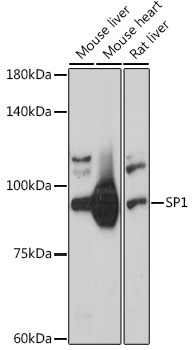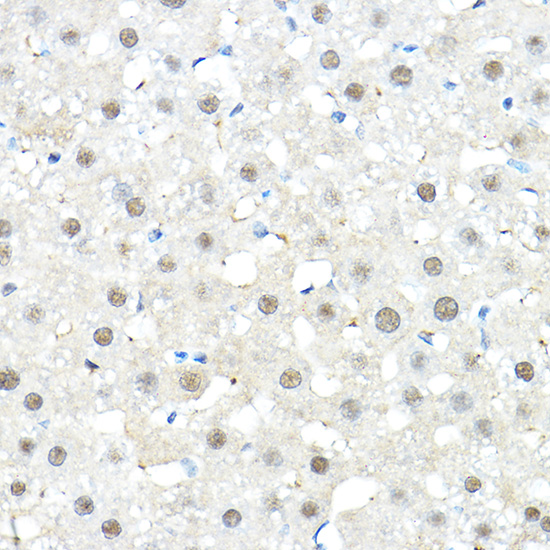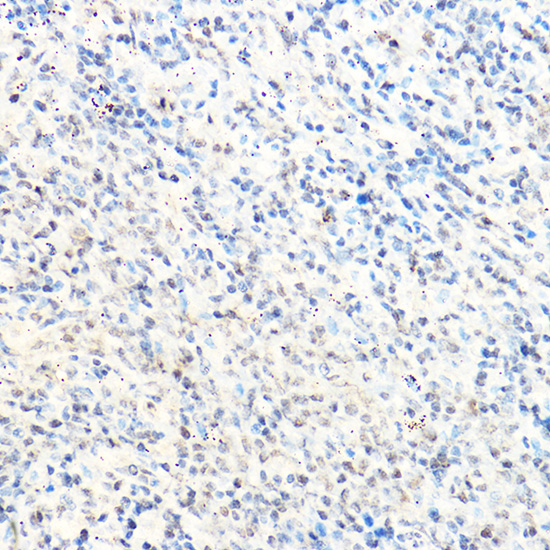Anti-SP1 Antibody (CAB14662)
- SKU:
- CAB14662
- Product type:
- Antibody
- Reactivity:
- Human
- Mouse
- Rat
- Host Species:
- Rabbit
- Isotype:
- IgG
- Antibody Type:
- Polyclonal Antibody
- Research Area:
- Cell Biology
Description
| Antibody Name: | Anti-SP1 Antibody |
| Antibody SKU: | CAB14662 |
| Antibody Size: | 20uL, 50uL, 100uL |
| Application: | WB IHC |
| Reactivity: | Human, Mouse, Rat |
| Host Species: | Rabbit |
| Immunogen: | Recombinant fusion protein containing a sequence corresponding to amino acids 420-620 of human SP1 (NP_612482.2). |
| Application: | WB IHC |
| Recommended Dilution: | WB 1:500 - 1:2000 IHC 1:100 - 1:200 |
| Reactivity: | Human, Mouse, Rat |
| Positive Samples: | Mouse liver, Mouse heart, Rat liver |
| Immunogen: | Recombinant fusion protein containing a sequence corresponding to amino acids 420-620 of human SP1 (NP_612482.2). |
| Purification Method: | Affinity purification |
| Storage Buffer: | Store at -20°C. Avoid freeze / thaw cycles. Buffer: PBS with 0.02% sodium azide, 50% glycerol, pH7.3. |
| Isotype: | IgG |
| Sequence: | LSGQ TFTT QAIS QETL QNLQ LQAV PNSG PIII RTPT VGPN GQVS WQTL QLQN LQVQ NPQA QTIT LAPM QGVS LGQT SSSN TTLT PIAS AASI PAGT VTVN AAQL SSMP GLQT INLS ALGT SGIQ VHPI QGLP LAIA NAPG DHGA QLGL HGAG GDGI HDDT AGGE EGEN SPDA QPQA GRRT RREA CTCP YCKD SEGR GSGD P |
| Gene ID: | 6667 |
| Uniprot: | P08047 |
| Cellular Location: | Cytoplasm, Nucleus |
| Calculated MW: | 75kDa/79kDa/80kDa |
| Observed MW: | 90kDa |
| Synonyms: | SP1 |
| Background: | The protein encoded by this gene is a zinc finger transcription factor that binds to GC-rich motifs of many promoters. The encoded protein is involved in many cellular processes, including cell differentiation, cell growth, apoptosis, immune responses, response to DNA damage, and chromatin remodeling. Post-translational modifications such as phosphorylation, acetylation, glycosylation, and proteolytic processing significantly affect the activity of this protein, which can be an activator or a repressor. Three transcript variants encoding different isoforms have been found for this gene. |
| UniProt Protein Function: | SP1: a transcription factor of the Sp1 C2H2-type zinc-finger protein family. Phosphorylated and activated by MAPK. Dephosphorylation by PTEN inhibits DNA binding. Binds to p38 in the nucleus. Interacts with Huntingtin and TAFII130. Transcriptional activity of SP1 and TAFII130 disrupted in early Huntingtin's Disease. |
| UniProt Protein Details: | Protein type:DNA-binding; C2H2-type zinc finger protein; Transcription factor Chromosomal Location of Human Ortholog: 12q13.1 Cellular Component: nucleoplasm; cytoplasm; nucleus Molecular Function:protein C-terminus binding; histone acetyltransferase binding; protein binding; protein homodimerization activity; DNA binding; sequence-specific DNA binding; metal ion binding; histone deacetylase binding; double-stranded DNA binding; bHLH transcription factor binding; transcription factor binding; transcription factor activity Biological Process: transcription initiation from RNA polymerase II promoter; embryonic placenta development; ossification; transcription, DNA-dependent; viral reproduction; megakaryocyte differentiation; positive regulation of transcription, DNA-dependent; embryonic skeletal development; embryonic process involved in female pregnancy; rhythmic process; cellular lipid metabolic process; enucleate erythrocyte differentiation; liver development; trophectodermal cell differentiation; regulation of transcription, DNA-dependent; transforming growth factor beta receptor signaling pathway; gene expression; positive regulation of transcription from RNA polymerase II promoter; embryonic camera-type eye morphogenesis; lung development |
| NCBI Summary: | The protein encoded by this gene is a zinc finger transcription factor that binds to GC-rich motifs of many promoters. The encoded protein is involved in many cellular processes, including cell differentiation, cell growth, apoptosis, immune responses, response to DNA damage, and chromatin remodeling. Post-translational modifications such as phosphorylation, acetylation, glycosylation, and proteolytic processing significantly affect the activity of this protein, which can be an activator or a repressor. Three transcript variants encoding different isoforms have been found for this gene. [provided by RefSeq, Nov 2014] |
| UniProt Code: | P08047 |
| NCBI GenInfo Identifier: | 13638437 |
| NCBI Gene ID: | 6667 |
| NCBI Accession: | P08047.3 |
| UniProt Secondary Accession: | P08047,Q86TN8, Q9H3Q5, Q9NR51, Q9NY21, Q9NYE7, E4Z9M7 G5E9M8, |
| UniProt Related Accession: | P08047 |
| Molecular Weight: | |
| NCBI Full Name: | Transcription factor Sp1 |
| NCBI Synonym Full Names: | Sp1 transcription factor |
| NCBI Official Symbol: | SP1 |
| NCBI Protein Information: | transcription factor Sp1; specificity protein 1 |
| UniProt Protein Name: | Transcription factor Sp1 |
| Protein Family: | Sex-specific storage-protein |
| UniProt Gene Name: | SP1 |
| UniProt Entry Name: | SP1_HUMAN |







